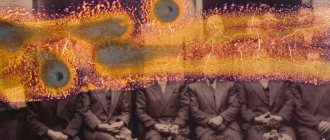Why does a person look away and not look into the eyes of the interlocutor when communicating: reasons, psychology
He's not necessarily lying, although most people would think so. In fact, a person may avoid contact with the other person's evil eye for a number of reasons.
Causes:
- Shyness
- Reluctance to engage in conversation
- Indecisiveness
- Sympathy for the interlocutor and shyness
- Irritation
- Lack of sympathy for your partner
- Deception
Why does a person look away and not look into the eyes of the interlocutor when communicating: reasons, psychology
A person looks into the eyes when talking: psychology
In general, a direct, piercing gaze does not always indicate sympathy. To understand what this view means, it is necessary to appreciate other details.
Causes:
- If the conversation is quite tense and not entirely pleasant. A man or interlocutor tries to expose and defeat the enemy with a long and piercing gaze.
- If you have a nice conversation and a man looks at you intently and straightens his hair and shirt, then this indicates that he is interested in you. He cares about you.
- With a piercing gaze and crossing your arms over your chest, you can talk about some kind of hostility or unwillingness to listen to your interlocutor. The opponent is not interested in the conversation.
- If a man looks at you intently and speaks in a low voice, this indicates flirting and sympathy.
A person looks into the eyes when talking: psychology
Visual Assessment Keys - 'Lying Eyes'
To the best of our knowledge, the first use of the term “Visual Assessment Keys” was by Richard Bandler and John Grinder in their book Frogs into Princes: Neuro Linguistic Programming.
Based on their own experience, they found the following: When asked a question, a “normally organized” person (who is not left-handed) directs his gaze in one of six directions, as seen from the perspective of the person looking at him:
Up and left
Indicates visually created images (VS)
If one is asked to imagine a "purple buffalo", then while the person is thinking about the question, imagining a "visually created" purple buffalo in his mind, his eyes will turn in that direction.
Up and Right
Indicates visually recalled images (VR)
If you ask a person, “What color was the first house you lived in?”, their eyes will turn in that direction as they think about the question, “visually remembering” the color of their childhood home.
Left
Indicates auditory created images (SS)
If someone is asked to imagine the highest sound possible,” then when he thinks about the question, “creating an auditory image” of a sound that he has never heard, his gases will turn in that direction.
Right
Indicates auditory recalled images (ER)
If you ask a person to remember what his mother's voice sounds like, then when he thinks about the question, trying to remember the sound, his eyes will turn in that direction.
Down and left
Indicates sensations/kinesthetics (O)
If someone says, “Can you remember the smell of a fire?”, that is the direction their eyes will turn when they think about the question, remembering the smell, sensation or taste.
Down and right
Indicates own dialogue (D)
A person’s eyes turn in this direction when he “talks to himself.”
Why is it important to make eye contact when speaking?
A strong and confident look is a demonstration of strength. It is not enough to speak confidently and back up your words with actions; you need to behave like a leader. This can be done by looking. Your gaze should be piercing. It is best if random passers-by lower their eyes when you look.
Reasons why gaze is important:
- A confident look makes you look better in the eyes of your interlocutor
- Shows your confidence and seriousness of intentions
- Talks about openness and honesty
Why is it important to make eye contact when speaking?
How to learn not to be afraid to look people in the eyes?
In most cases, people do not look the other person in the eye because of fear and uncertainty. But among politicians and coaches there are special exercises that allow you to look your opponent in the eye. This increases trust on the part of the interlocutor and can be a serious weapon during debates and arguments. Below are tips that will allow you to learn how to confidently look your interlocutor in the eyes.
Recommendations:
- Do daily workouts. To do this, just practice on passers-by. Look into their eyes.
- It is also worth doing exercises for the eye muscles. You need to draw figure eights with your eyes closed and open.
- Spend a few minutes a day assessing how you look in the mirror. This way you can understand what you look like from the outside.
- If you initially find it difficult to learn to look into the eyes, you can focus on the bridge of your nose.
- In the evening, when talking with your interlocutor, concentrate your gaze on the point to the left of your opponent’s face.
- If you notice that as soon as you make eye contact with your opponent and he looks down, you have achieved your goal.
How to learn not to be afraid to look people in the eyes?
Learning to make eye contact is not difficult at all. This requires desire and regular training.
Modalities of internal experience.
Let's learn some new terms. Firstly, I want you to be able in the future to read and understand any literature on hypnosis where these terms are used; and secondly, it will be more convenient for us to use these terms in our further work. So, the division of internal experience into three categories (vision, hearing, sensations) that we made is called the division into modalities of internal experience. Everything that relates to vision - memories and representations of visual images - is called visual modality (from the Latin "visus" - vision). Auditory memory is called the auditory modality (the term has the same Latin root as the word “audio system”), and the experience of movements and touches is the kinesthetic modality. A person whose thinking is dominated by visual images, who “specializes” in visual internal experience, will be called a visualist, specializing in auditory experience - an auditory person, specializing in sensations, in kinesthetics - a kinestheticist.
I have been observing you for some time now, and I have identified your leading modalities for myself. So, for example, I think that the attention of the men of the group is attracted to Natasha not only because she is a pretty girl, but also because she is a kinesthetic person... It would be unfair to hide the leading modalities of everyone else. Let's do this: sit in a circle so everyone can see each other. I will ask you a question, which you will answer and at the same time notice the answers of your partners. So the question is: “How do you learn about the world?..”
Igor: Should we talk about this?..
S. Gorin: There’s no need to say anything, you’ve already answered with your eyes! And in general, I would like to know how you can answer this question in words, you don’t realize the answer! You all responded with your eyes, and those who watched can take note of your leading modality. By the way, in this exercise one could see an interesting detail, I noticed it a long time ago: in the subspecies of homo sapiens, homo sapiens, called “homo soveticus” (Soviet man, read Zinoviev), the first movement of the eyes in response to unclear questions is into an internal dialogue, that is, in speech control. Don't spill the beans! Chatterbox is a godsend for a spy! We are secretive people, after all...
Information about the leading modality can be obtained not only from ocular access signals; the interlocutor always tells you about it in words. A person's choice of words is associated with his leading modality; if he talks about “a bright future, a bright prospect, a point of view,” then he chooses visual words that correspond to his leading visual system. The auditory modality corresponds to words and expressions like: “monotonous, muffled, speak louder, let’s talk,” etc. Kinesthetic words: “touch, touch, softly, roughly, warmly, coldly, presses,” etc. Words indicating on the basic modality of a person also have their own name - “predicate words”. There are also words that do not belong to any modality: “know, understand, think” (sometimes they are referred to as the so-called speech motor modality, but this term is rarely used). Until now we were interested in how to speak, and now we will deal with what to say.
The fact is that we usually organize and format our message in such a way that it is convenient for us to convey it... But to effectively influence a person, it is much more important to format the information in such a way that it is convenient to receive it. You can transmit a command through a state-of-the-art television station, but what good is that if the potential performer doesn't even have a detector receiver? If in this situation you still want to be understood, you will have to invite a signalman with a flag. Do we rarely see when in business communication one person says: “Just look!”, and the other objects: “No, listen!” Vitaly is a kinesthetic learner; I can spend an hour outlining to him the brilliant conditions and bright prospects for cooperation with me, showing him the bright horizons open to him, and inviting him to ultimately accept my point of view. Please - he sits and shakes his head in displeasure. But if I, in a warm and sincere tone, let him feel the ease of our close contact... as you can see, he became interested. Learn to speak to a person in such a way that it is convenient for him to listen to you, so that your words coincide with his inner experience.
Exercise
Performed in pairs. First, draw a simple diagram for yourself (see diagram 2): in the center of a sheet of paper, draw a more or less schematic eye and indicate 8 directions of gaze - 3 directions up (right, center, left); 2 directions horizontally (right and left); and 3 directions down (right, center, left). Now, in each of these directions, write three or four words that correspond to the modality that matches the direction. For example, for the visual modality these would be the words: “look, bright, brilliant”; on the right you can add “imagine.”
Question from the audience: Can I use the word “gold”?..
S. Gorin: Well, for me “gold” is something kinesthetic, although I never carried it in bullion... It’s better to write something more specific. Yes, the direction of looking straight ahead with a defocused gaze, “absent gaze” - this direction cannot be shown on your diagram, but you remember that this is also a visual direction. The “absent look” is also accompanied by dilated pupils, as a rule. For a horizontal direction of gaze, use words of the auditory modality - “listen, speak, loudly, quietly.” The same words are suitable for directing the gaze down to the left (internal dialogue). Well, for kinesthetic areas - “touch, touch, hot, cold.”
Scheme 2. Verbal connection to the direction of gaze.
| Look Bright Shiny | Look Bright Shiny | Imagine Bright Shiny |
| Listen Talk Loud | (o) | Listen Talk Loud |
| Listen Talk Loud | Touch Touch Hot | Touch Touch Hot |
Now - the exercise itself. Partner A holds the chart next to his face and shows Partner B all eight directions of gaze in turn. Partner B reads the words from the chart that correspond to each direction and says them out loud. Yes, you show the direction of your gaze, of course, with your own eyes. Then you switch roles. The second part of the exercise is also performed with a diagram. Partner A gives 3-4 directions of gaze randomly, unsystematically, partner B also reads and pronounces the corresponding words out loud, then change roles. In the third part of the exercise, you do the same thing, only without a diagram, from memory. Get started.
Everything you do still has to do with rapport. If earlier you joined your partner’s external behavior, now you are practicing joining his internal experience. A very simple example - if I tell you “Look!”, this means that I am not just inviting you to look at something, having constructed some kind of internal “picture” for this; this means that I have constructed such a “picture” for myself and will respond fully only to “visual arguments”. There are some patterns in the distribution of leading modalities among different people (however, rather imprecise). For example, women are more likely to specialize in the visual modality, while men are more likely to specialize in the kinesthetic modality. The auditory modality as a leading modality is quite rare: among musicians, among some managers. According to my observations, the Soviet boss uses 80 percent vague and auditory words in his speech (our current mayor, for example, is a typical auditory person who loves beautiful-sounding words).
Reply from the audience: That’s why few people understand our leaders.
S. Gorin: They don’t need it. But when you become a boss, keep in mind that the most common modalities are visual and kinesthetic. You might want to be understood... Since you're the rank-and-file workers, let's learn one more skill. You need to learn to overcome the speech limitations associated with your own modality. That is, you must become qualified translators from the language of one modality to the language of another. I will give you something like a dictionary, later you will add to it... This is a table (see Table 1), in which words from four groups are given vertically: indefinite, visual, auditory, kinesthetic. Horizontally, a word from one column matches words from adjacent columns.
Exercise.
Now you will have a break, and you will still discuss something, exchange views, opinions, feelings. Take one single modality for yourself, stay within the vocabulary of one vertical column of the table during the conversation. You can try several modalities, but stay in only one of them for each period of time.
Natasha: Can I take my native modality?
S. Gorin: It’s possible, but it will be too easy for you (laughter in the audience). Take someone else's, practice...
TABLE 1. Mutual translation of the language of modalities.
| Undefined | Visual | Auditory | Kinesthetic |
| Installation | Perspective, point of view | Comment, opinion | Directionality, slope, stance |
| Think out | Illuminate | Discuss | Feel |
| Be persistent | Look out, track down | Listen, eavesdrop | Achieve, persist, hold on |
| Demonstrate | Show | Explain | Scatter, pull, sort |
| Emit something | Shine, radiate, sparkle | To sound, to resonate | Tremble, vibrate |
| Absent | To be empty, clean | To be stunned, speechless | Be numb, freeze |
| Ordinary, familiar | Dim | Monophonic, muffled | Lethargic, flabby, tasteless |
| Noticeable and attention-grabbing | Bright, ostentatious, flowery, conspicuous | Loud, deafening | Sticky, stubborn, amazing |
| Be careful | Take a closer look, take a closer look | Listen | Worry, worry |
| Ignore | Overlook | Can't hear | Don't feel it, miss it |
| Make it noticeable and attract attention | expose, manifest | proclaim, announce | bring forward, put forward |
| Notice | Inspect | Listen closely | Feel it |
| Play, repeat | Review, review, view | Talk, talk | Walk along..., drive away |
| Outline | Show | Tell | Conduct |
| Come up with | Imagine | Remember the sound | Grasp, embrace |
| Remind about something | Look familiar | To agree with something, to be in tune with something | Dock, touch |
| Draw attention to something | Specify | Hint | Touch |
| Deprived of sensations | Blind | Deaf | Unfeeling |
| Let's think about it | let's consider | Let's talk | Let's figure it out |
Discussion. Self-reports from participants: - It was not difficult to communicate in visual and kinesthetic language, with others there were problems... - Vague words were difficult for me... - There was a feeling of artificiality of such communication, I can’t believe that it could be effective.
S. Gorin: I talked about overcoming the barrier of your own modality, and the difficulties that you encountered simply pointed out to you those areas where you still need to improve. Well, regarding the artificiality of communication... I will add one more argument to you, the example of A. Sitnikov: “... This happens when we are watching a television report and the image suddenly disappears. The announcer, who is sitting there in the stadium, is trying to tell you what he sees: “Look at that blow!” What do you see? You see a flicker. If the announcer knew that you were not seeing the image at this time, he would pretend to be a radio reporter and begin to convey information so that you imagine: “He dribbles with his right foot, the ball is flying here...”. So that it doesn’t become like this: “Look how interesting it is, you need to know which one.” To prevent this from happening, information must always be organized from the communicator (receiver). Do not transmit on the wavelength on which it is convenient to transmit, but transmit on the wavelength on which it is convenient to perceive. If I transmit information in the modality in which my partner is currently working, the result is the same as in the color decoding system. I encode the signal in the same color encoding system in which it decodes the same signal. If I encode in the PAL system, and he decodes in the SECAM system, then the result is a black and white image... My arguments and beliefs are not so bright. And he is unlikely to perceive my words as very important information. And it is for this that you need to use the modality that occurs in it. In general, it’s great that there are indicators that allow you to find out in which modality your partner is working.”











